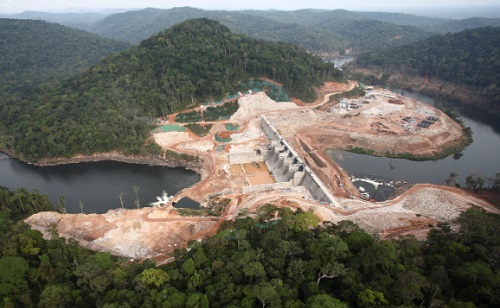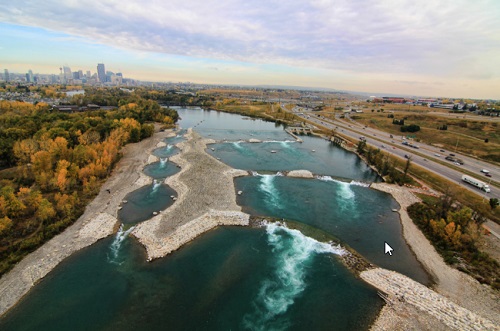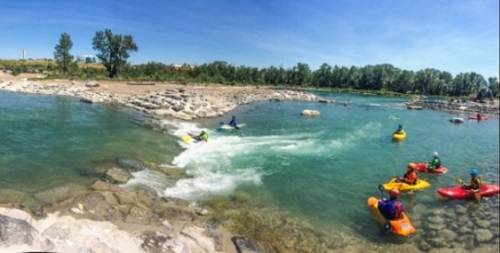Sustainability by Design
June 29, 2018 |
This month’s blog post highlights the sustainable attributes of four KCB projects, including the design and construction of the Nam Theun 2 hydroelectric dam in Laos, and in Canada, the decommissioning of a diversion dam on Vancouver Island, the re-development of the Cascade Falls hydroelectric dam in British Columbia, and the rebuild of a weir on the Bow River in Calgary, Alberta.
Nam Theun 2 Hydroelectric Project
Nam Theun 2 is a 1,074 MW hydroelectric dam in Laos. It is the cornerstone project in a long-term collaborative effort between Laos and Thailand to develop up to 3,000 MW of hydropower energy in Laos, mainly for export to Thailand. The project incorporated best environmental practices and heritage designs of the Lao people.
KCB designed surface water management systems that protect and stabilize embankments and slopes, and managed the handling, treatment and monitoring of drainage water from the powerhouse. KCB’s design of the powerhouse incorporated traditional Lao architectural elements.
Aggregate materials for the dam’s construction were sourced and crushed at a local quarry, rather than hauling materials from long distances or dredging river deposits. Excavated materials from the project site were re-used for roads and flood protection.
At the peak of construction, the project employed over 8,000 workers, 80% of whom were Lao. The construction also generated indirect jobs for small community businesses providing supplies and services to the construction effort. In addition, new housing and community buildings with electricity were built for 6,500 local residents.
In 2010, KCB was awarded the ACEC-BC Award of Merit and the ACEC-Canada Award of Excellence for this project.
Sustainable Project Attributes- Responsible water management
- Design to improve social conditions
- Design to reduce, repurpose or reuse remaining materials

Decommissioning of the Salmon River Diversion Dam
The Salmon River Diversion Dam, located on Vancouver Island, was built in 1958 to divert flow from the Salmon River into the Lower Campbell Reservoir to increase the capacity of the Ladore and John Hart Hydro Facilities. The diversion dam infrastructure was ageing and required rehabilitation to continue operations and improve fish passage at the dam.
KCB and Hatch Ltd. were engaged by project owner BC Hydro to develop a plan for the dam’s decommissioning and restoration of the Salmon River channel. BC Hydro together with Wei Wai Kum and We Wai Kai First Nations co-managed the project from planning through to implementation and completion.
The dam was constructed from creosote-treated timbers, requiring careful dismantling and disposal of materials. The natural flow of the Salmon River was restored allowing for unhindered fish passage upstream. Fish will now be able to pass into the upper reach of the Salmon River watershed without being impeded by constructed barriers.
Throughout the project, local community organizations were consulted and were very satisfied with the outcome of the project. The project recently won an ACEC-BC Award of Merit in the Natural Resource and Habitat category.
Sustainable Project Attributes- Responsible water management
- Special consideration for flora and fauna
- Rehabilitation
- First Nations integration and application of traditional knowledge

Cascade Hydroelectric Project
The Cascade Heritage Hydroelectric Project is a 28-megawatt facility located on the Kettle River near Christina Lake, British Columbia. Cascade Water Power and Light Company first developed the Cascade Falls in 1895. In 1919 the plant was shut down because of cheaper power sources from the Kootenay River hydroelectric dams.
The Cascade Falls site has historical significance because it was one of the first to use 3-phase 60 hertz alternating current. The heritage aspect was incorporated into the project with a museum and recreation park. KCB was retained by the Client, Powerhouse Energy Corporation, to carry out the first stage of the feasibility study.
At one point, one of the valves in the penstock developed a leak. Instead of replacing the entire valve, KCB designed a new seal and refurbished the valve, eliminating the need to fabricate another valve and reducing the amount of steel needed.
During the project’s environmental assessment, several revisions were made to the original design. The principal change involved decreasing the height of a weir to minimize potential impacts on fisheries in the Kettle River. Currently, the project has a high rubber dam that is 3 m high when fully inflated, with a fishway and a low-level outlet at the right bank.
KCB completed a study for the current configuration. An impact of diversion structure on the upstream water levels was determined by comparing water levels under natural conditions with water levels with the weir in place. KCB was involved in the environmental approval process and participated in meetings with environmental agencies and First Nations.
Sustainable Project Attributes- Special consideration for flora and fauna
- Design to reduce, repurpose or reuse remaining materials
Harvie Passage
In 1904, a weir was built across the Bow River in Calgary to divert water into a canal system that provides irrigation water for agriculture. However, it created a dangerous hydraulic wave that prevented movement of non-motorized boaters up or down stream and claimed several lives. Harvie Passage was designed to eliminate the extreme drowning hazard by building several smaller rapids. It enables safe river passage for non-motorized boats and fish, while maintaining diversion for irrigation.
KCB was retained by Alberta Transportation and Parks Foundation Calgary for the final design, tendering and construction administration of the Harvie Passage, which was completed in May 2011. Unfortunately, the unprecedented flood of the Bow River in June 2013 significantly damaged it. Sections of the Harvie Passage were filled in by sediments deposited by the flood, an old river channel along the right riverbank was eroded, and low downstream river levels resulted in unsafe hydraulic conditions. Following the flood’s aftermath, KCB was retained by Alberta Transportation to rebuild Harvie Passage.
The new Harvie Passage was designed to:- increase safety and navigability, while re-establishing the beautiful design;
- improve fish passage and habitat;
- reduce costs of Alberta’s Environment and Parks safety measures;
- develop new opportunities for recreational boating; and
- increase tourism to Calgary and the surrounding area.
In addition, bio-engineering slope protection and reuse of woody debris provides erosion protection and fish and wildlife habitat.
The Harvie Passage project was conceived and implemented by a group of stakeholders, who were involved in the development of the project safety plan and throughout construction and commissioning.
Sustainable Project Attributes- Special consideration for flora and fauna
- Rehabilitation
- Design to improve safety conditions


Also take a look at our 2017 Sustainability Report, where we report on the economic, social and environmental impacts of our business over the past year. We highlight our continued investment in new technology, helping to increase efficiencies and deliver better, sustainable solutions to our clients.
